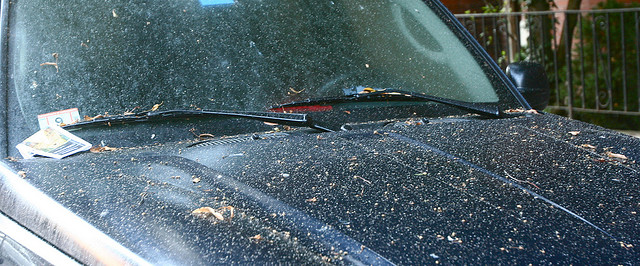Last Updated on February 8, 2023 by
It is one of the most difficult contaminants to remove sap from cars, but tree sap boasts many benefits. It is used for a variety of beneficial purposes. Natural antiseptics and astringents can be found in some saps. The medicine can relieve a sore throat when chewed like gum. As well as making syrup, the Sap can be used as a waterproofing agent and as a fire starter. Since Sap is the lifeblood that courses through the body of a tree, it is, of course, beneficial to the tree. But what about tree sap on your car? That’s not so good.
The Sap from trees falls naturally in the spring as the weather warms. In some cases, the liquid appears as light, sticky droplets. It might appear to be a solid substance that you cannot rinse off but is stuck firmly to the paint if you do not pay attention. Sap can stick to the color of your car if you park in the shade to avoid the sun or you have trees lining your driveway. Because it is thick and sticky, it is challenging to remove once it accumulates there. Leaving tree sap on the tree for long periods, especially when baked in the sun, will result in a thick resin that is extremely difficult to remove. More importantly, eliminating tree sap incorrectly can cause more harm than good.
Sap from cars
Sap from a car refers to a sticky, resin-like substance that can sometimes leak from trees and onto vehicles. This sap can be difficult to remove and can cause damage to the car’s paint and finish if left untreated. Sap from trees is produced as a result of photosynthesis and helps to protect the tree from damage and disease.
However, when it comes into contact with a car, it can cause a number of problems. The sap is high in sugar and can attract dust and other debris, making it even more difficult to remove. It can also cause discoloration and fading of the car’s paint, and in extreme cases, it can even damage the clearcoat.
To remove sap from a car, it’s important to use a specialized cleaning product and follow the manufacturer’s instructions carefully to avoid damaging the paint. Regular washing and waxing can also help to protect the car from future scratches.
Tree sap
Your car’s windows and paint job are as vulnerable to damage from tree sap as they are from bug residue or bird droppings because they can disfigure the paint and damage the wipers. In this case, John Ibbotson, chief mechanic for Consumer Reports Auto Test Center, recommends removing the sap as soon as possible since it will eat into the paint over time.
As a result of heat, sap adheres more quickly to the car’s paint. When you find tree sap on your vehicle, it is often recommended that you remove it immediately. Regularly checking your car for tree sap and cleaning it when you see it is an effective way to keep track.
Effects of tree sap on car’s paint
Tree sap typically does not chemically eat into the paint on your car like some other contaminants, such as bird droppings, bug splatter, acid rain, or hard water spots. In addition to the other substances listed above, each can etch the clear coat finish and cause physical damage. In general, tree sap does not affect the look of your car unless it has recently been painted.
However, this does not mean that tree sap cannot cause problems. Tree sap is, first of all, an unsightly mess. It gives the paint a stained appearance. The rough surface makes it difficult to paint. Its sticky nature causes other contaminants, such as dust and sand, to collect, adding to its unsightly appearance.
Nevertheless, the most significant impact of tree sap is what happens when it is not treated for long. The fluid is produced by trees in the form of a light liquid. In contrast, when it bakes in the heat of the sun, where surface temperatures reach 160 degrees on your car, it forms a thick, tar-like substance and then eventually solidifies. Once it has reached that point, Sap is impervious to ordinary car wash chemicals and creates a strong bond with your paint. The clearcoat of a panel can be scratched if you try to scrape off hardened tree sap.
How to remove tree sap from car?
When tree sap is left in place for a long time, it becomes increasingly difficult to remove, so it is best to remove it right away. Liquid from freshly tapped trees is usually transparent and hard to detect. Therefore, to keep your car clean, if you frequently park beneath trees, particularly maple trees whose Sap drops significantly and pine trees whose Sap is exceptionally sticky and challenging, you should regularly wash your car. At least once a week. Fresh Sap can be removed from your paint by driving through an automatic car wash, but once it’s dried, it’s not nearly enough to eliminate stains.
The best way to prevent Sap from sitting on your vehicle is to purchase a car wash membership, which entitles you to unlimited soft-touch car washes for a monthly fee. Any time you see Sap accumulating or other contaminants, you can drive through. A hand wash might do the trick if you don’t work directly in the sun or beneath the sap-dripping trees. Unfortunately, DIY car washing can result in scratches to paint if it is not done correctly. If Sap remains, make sure to remove it as soon as possible.
It is also a good idea to keep your car covered with a protective product to avoid sap contamination. Using wax, polymer sealants, and ultra-durable ceramic coatings will create a slick, waterproof barrier that will prevent Sap from sticking and make it easier for you to wash it off. While Zep’s Armor All ® Extreme Shine Wax and Rain-X Complete Surface Protectant are not considered replacements for hand- or machine-applied products, they are excellent supplements for renewing your sealants and waxes between applications.
Read More: How To Clean The Inside Of Your Windshield? An Important and Comprehensive Overview
Easy ways to remove sap
At an early stage is relatively straightforward. You can remove all the loose contaminants by giving the car a basic wash. You may be able to remove the Sap with a car wash if you catch it early enough. Test for residual contaminants, such as Sap, upon drying your car on the paint surface. A sticky substance and a rough surface may be felt if Sap is present. The dried-on, hardened Sap can be seen as dark amber spots that are either goopy or hard (in the worst cases). As soon as the Sap reaches that level, aggressive measures must be taken.
Consequently, it is imperative to use gentle methods to remove Sap from painted surfaces to prevent scratching. Here are a few options for gently removing dried Sap:
- The clay bar. The clay bar is part of a composite putty material. Clay bars are used in auto detailing to remove solids from paint. They are used in conjunction with detailing liquid spray. Clean a panel of dirt and debris, then spray it with a detailing solution or clay bar lubricant. After the detailer has spread the panels, rub a kneaded clay bar across the contaminants, in addition to dirt, rail dust, and tree sap.
- The clay bar removes tar and tree sap. Clay bars remove Sap physically, while tar and sap removers soften Sap chemically. Take your time. As the solvent eats its way through the Sap, it may take some time for it to unwind. WD40, margarine, rubbing alcohol, mineral spirits, and even bacon grease are popular tar and sap removers alternatives. No matter what cleaning product you use, use microfiber towels to prevent scratches.
- Use a plastic razor blade. To remove Sap physically, you can use a plastic razor blade to scrape it off gently. Never use a metal blade! Be gentle with the sword. When used in conjunction with tar and sap remover, this tool might be helpful in large, hardened drops of Sap.
- You might be able to soften stuck-on tree sap with a household steam wand. Some people suggest using this method to clean a convertible top of Sap. It can also help make the substance more flexible so that other ways are more effective. Steam alone will not remove the importance.
Regardless of which sap cleaning method you choose, time is of the essence. It is better to treat it as soon as possible. Combining techniques might help. In most cases, chemicals will not penetrate the clearcoat of your car as long as the paint hasn’t recently been applied (as in, it’s just come back from the body shop). Although acetone may dull your color a bit, it will not harm it. Ensure that you do not scrub too aggressively or apply too much pressure to the panel. You can add tree sap to pancakes to make them delicious. On your car, however, it is a much less appealing sight.
FAQs
- How can I remove tree sap from my car?
Turtle Wax’s Bug and Tar Remover (under $10) is recommended for cleaning bugs and tar from cars.
- Do tablespoons of vinegar remove Sap from cars?
Fill a spray bottle with distilled white vinegar to safely remove tree sap from your windshield: Distilled white vinegar can be found at any grocery store.
- Is Sap harmful to the paint job of cars?
Water can often drip onto your car or whatever is below it. The Sap from trees is unsightly if left alone. The paint job on your vehicle can be damaged if you do this, and rust can occur.

